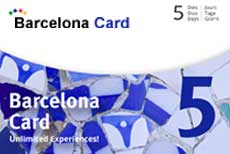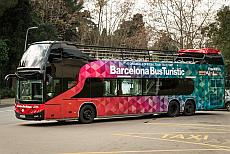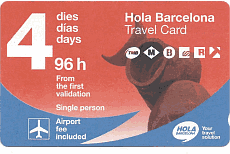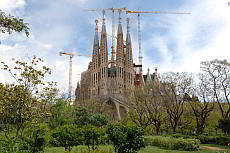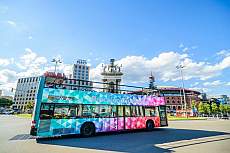FC Barcelona - Més que un Club (More than a club)
History of the club, current squad, stadium tour, and home games
FC Barcelona, commonly known as Barça, is the second-largest sports club globally, its stadium Spotify Camp Nou is the largest in Europe, and it has the most registered fan groups among European clubs.
Contents of this page
FC Barcelona is an essential part of the history of Barcelona and Catalonia and is among the most successful and renowned football clubs in the world.
On match days, you can feel throughout the city that Barça is more than just a football club – the motto is not without reason: "FC Barcelona - Més que un Club". Just as you don't have to be religious to be fascinated by Gaudí's Sagrada Familia, you don't have to be a football fanatic to feel the excitement in the air on match days.
Barcelona has won numerous national and international titles, including several Spanish championships (La Liga), Spanish Cups (Copa del Rey), and UEFA Champions League titles. The club also has a remarkable academy, called La Masia, known for developing many talented players, including legends like Lionel Messi, Xavi Hernandez, and Andres Iniesta.
Tickets for home games and stadium tours
Attending a home game of FC Barcelona is one of the highlights in Barcelona, much like the Sagrada Familia. However, due to stadium renovations, games will be held at the Olympic Stadium.
The Spotify Camp Nou is currently closed for tours, but the FC Barcelona Museum and a viewing platform overlooking the construction site remain accessible.
- Football fans, take note: Experience an unforgettable day at the stadium!
- Visit the museum + audio guide
- Spotify Camp Nou Live immersive space
- Viewpoint of the Camp Nou construction site
- This new exhibition at Camp Nou is full of exciting impressions! It concludes in a large audiovisual room called SPOTIFY CAMP NOU LIVE, a large-format immersive show where a 360° experience unfolds.
Here, you will feel as if you are standing right in the stadium, as though you were part of the team! You will experience the emotions that make Europe's largest stadium unique from a one-of-a-kind perspective.
- This product is our recommendation because it's a great combo: a ticket for visiting the museum (quite exciting and impressive) and with the Hop-on Hop-off bus, you can get around easily and visit many attractions.
- Book once and enjoy an unforgettable experience with this convenient combo package!
- Bus Turístic Barcelona: Hop-on Hop-off City Tour
- Hop-on Hop-off ticket for the red and blue lines with over 40 stops in the city
- Audio guide on board (including headphones)
- City map
- Discounts for various activities in the city
- FC Barcelona Immersive Tour & Museum: Standard Entry Ticket
- Visit the museum + audio guide
- Spotify Camp Nou Live immersive space
- Viewpoint of the Camp Nou construction site
- This new exhibition at Camp Nou is full of exciting impressions! It ends in a large audiovisual room called SPOTIFY CAMP NOU LIVE, a large-format immersive show where a 360° experience unfolds.
Here, you will feel as if you are standing right in the stadium, as though you were part of the team! You will experience the emotions that make Europe's largest stadium unique from a one-of-a-kind perspective.
- Experience the thrill of FC Barcelona games with a variety of ticket options. Feel the excitement live in the stadium with options for grandstand, side, corner, and goal seats.
- FC Barcelona Game Ticket
- An FC Barcelona home game is an unforgettable experience
- Should you experience it? We think so: The atmosphere in the stadium is exceptional, the whole stadium is electrified. You will remember it for a long time
- Experience a Barça game up close and sit in the front row near the players. Youll be right in the corner with the cheering Barça fans, so youre in the heart of the action!
- Discover the history and culture of Barça, guided by a passionate Culer
- Experience the game like a real fan
- Immerse yourself in Barça's culture, history, and atmosphere
- And the best part? Youll be accompanied by me, a mega Barça fan who has been attending games since childhood, ensuring you have the ultimate experience.
- Well start with a pre-game tour, exploring the coolest spots inside and outside the stadium. Along the way, you'll learn about the club's history and get excited for the start of the game.
- Languages: English, Spanish
- Stops at Camp Nou and Olympic Stadium
- Audio guide available in English and other 16 different languages
- 2 different routes
- Tickets for 1 or 2 days
- Unlimited Hop-On/Hop-Off bus ticket for the selected period
- Wi-Fi on board
- Operating hours: 09:00 - 19:00 (last start from Plaça Catalunya)
No service on 25th December and 1st January - Duration: red and blue lines approx. 120 minutes if you stay on, every 20-30 minutes
- Voucher booklet for attractions, restaurants, and shops
- Buses wheelchair accessible (lower deck)
Schedule and results 2024/2025
FC Barcelona Home Games for the Current Season
- Sun. 18.05.2025: FC Barcelona vs Villareal
* Game time not yet confirmed
Results of League Home Matches current season
- Sat. 24.08.2024: FC Barcelona vs Ath. Bilbao: 2:1
- Sat. 31.08.2024: FC Barcelona vs Valladolid: 7:0
- Sun. 25.09.2024: FC Barcelona vs Getafe: 1:0
- Sun. 20.10.2024: FC Barcelona vs Sevilla: 5:1
- Sun. 03.11.2024: FC Barcelona vs Espanyol: 3:1
- Sat. 30.11.2024: FC Barcelona vs Las Palmas: 1:2
- Sun. 15.12.2024: FC Barcelona vs Leganes: 0:1
- Sat. 21.12.2024: FC Barcelona vs Atl. Madrid: 1:2
- Sun. 26.01.2025: FC Barcelona vs Valencia: 7:1
- Sun. 02.02.2025: FC Barcelona vs Alavés: 1:0
- Mon. 17.02.2025: FC Barcelona vs Vallecano: 1:0
- Sun. 02.03.2025: FC Barcelona vs Real Sociedad: 4:0
- Sat. 27.03.2025: FC Barcelona vs Osasuna: 3:0
- Sun. 30.03.2025: FC Barcelona vs Girona: 4:1
- Sat. 05.04.2025: FC Barcelona vs Real Betis: 1:1
- Sat. 19.04.2025: FC Barcelona vs Celta Vigo: 4:3
- Tue. 22.04.2025: FC Barcelona vs Mallorca: 1:0
- Sun. 11.05.2025: FC Barcelona vs Real Madrid: 4:3
League position
- 1st place, 85 points
- 27 wins, 4 draws, 5 losses
- Goals 97:36
2024/2025 squad
First day of work for coach Hansi Flick
- Hansi Flick
- Heiko Westermann (assistant coach)
- Marc-André ter Stegen (No. 1)
- Iñaki Peña (No. 13)
- Ander Astralag (No. 26)
Centre-back
- Ronald Araujo (Nr. 4)
- Andreas Christensen (Nr. 15)
- Pau Cubarsí (Nr. 2)
- Eric García (Nr. 24)
- Iñigo Martínez (Nr. 5)
Left-back
- Alejandro Balde (Nr. 3)
Right-back
- Jules Koundé (Nr. 23)
- Héctor Bernal (Nr. 32)
Defensive midfield
- Marc Casadó (Nr. 17)
- Marc Bernal (Nr. 28)
Central midfield
- Gavi (Nr. 6)
- Pedri (Nr. 8)
- Frenkie de Jong (Nr. 21)
- Fermín López (Nr. 16)
Attacking midfield
- Dani Olmo (Nr. 20)
- Pablo Torre (Nr. 14)
Left wingers
- Ferran Torres (Nr. 7)
- Ansu Fati (Nr. 10)
Right wingers
- Lamine Yamal (Nr. 19)
- Raphinha (Nr. 11)
Center-forward
- Robert Lewandowsky (Nr. 9)
- Pau Víctor (Nr. 18)
The information also includes substitute and rotational players.
History of FC Barcelona
Since its founding in 1899, FC Barcelona has experienced many highs and lows. Sporting achievements such as winning the Champions League and capturing five trophies in a single year are just two of the many highlights. The assassination of President Josep Suñol by Franco's henchmen is one of the many low points in the club's history.
Founding of FC Barcelona by Hans "Joan" Gamper
Hans-Max Gamper was born on November 22, 1877, in Winterthur, Switzerland. After the death of his mother, his family moved to Zurich. Besides various sports such as cycling, rugby, running, tennis, and golf, he was also captain of the Basel football team. On his way to Africa to help with the construction of sugar factories, he visited his uncle Emili Gaissert in Barcelona in 1888. There, Gamper fell in love with the city, learned Spanish and Catalan, and adopted the Catalan name Joan.
Joan Gamper founded the sports magazine Los Deportes and published a classified ad on October 22, 1899, to establish a football club in Barcelona. The response was great, and on November 29, 1899, the first meeting took place, where Swiss, English, as well as Catalan and Spanish football enthusiasts gathered. This meeting marked the birth of FC Barcelona. Besides Joan Gamper, other founding members of the club included Pere Cabot, Enric Ducal, and Otto Kunzle.
The first president of FC Barcelona was the Englishman Gualteri Wild, while Gamper preferred to play as a captain in the team. The club's first match ended in a 0-1 defeat against a selection of English expatriates.
In 1908, Gamper became president and held this position five times until 1925. Among his achievements was the construction of the first stadium "La Escopidora". Until the opening of the stadium on March 14, 1909, at Carrer d'Indústria, which had a capacity of 6,000 spectators and was the first stadium in Spain with floodlights, FC Barcelona played on various temporary fields.
In 1925, Gamper was expelled from the country by the military dictatorship under Miguel Primo de Rivera, a supporter of Real Madrid, due to an incident during an international match against England, where Catalan fans mocked the Spanish national anthem. This led to the temporary closure of the stadium.
Since then, FC Barcelona has seen itself as the national team of Catalonia. Although this stance has somewhat changed, the Spanish national team remains a symbol for many Catalans that does not represent their region.
After his expulsion, Gamper returned to Switzerland, where he suffered from depression and committed suicide on July 30, 1930, at the age of 52.
The Golden Decade of 1919 to 1929
The Golden Decade is a period of extraordinary sporting success and significant growth for FC Barcelona, establishing the club as one of the dominant forces in Spanish and European football. Joan Gamper, who was president of the club until his forced resignation in 1925, significantly shaped this era.
During this time, the club won the Spanish championship (La Liga) five times and secured the title as the first winner of the newly founded Primera División, the highest Spanish league, in 1929.
A significant milestone was the opening of Camp de les Corts in 1922, which had a capacity of 30,000 spectators and provided the club with a modern stadium for its growing fan base. The club also experienced a financial boom during this period, securing a solid foundation for future successes.
The 1930s and the Spanish Civil War
In the early 1930s, FC Barcelona faced difficult times. Membership declined, the club had financial problems, and sporting successes were lacking. The fascist dictator Miguel Primo de Rivera, who had also expelled Joan Gamper, closed the stadium. During the Spanish Civil War, the stadium served as a military barracks.
On August 6, 1936, a month after the start of the Spanish Civil War (July 1936 to April 1939), Josep Suñol, the president of FC Barcelona, was shot by Franco's troops. At that time, the team was on a tour of Mexico and the USA, although many players were already living in exile in France and Mexico.
On March 16, 1938, a bomb fell on the club building, causing significant damage. In March 1940, the presidency was replaced by Franco-loyal individuals. The "Futbol Club Barcelona," an Anglicized name derived from "football club," was renamed to the Spanish name "Club de Fútbol Barcelona." At that time, the club's membership was reduced to around 3,500. The four red stripes on the club's crest were reduced to two. It was not until 1973 that the club regained its original name "Futbol Club Barcelona."
The Rise in the 1940s
In the 1940s, FC Barcelona experienced a sporting revival. After a period of decline and financial difficulties, during which the club nearly faced relegation, Barça won the Spanish championship (La Liga) again in 1940.
By 1949, the club's 50th anniversary, FC Barcelona had around 25,000 members and achieved significant successes: 21 Catalan championships, 9 Spanish Cup wins (Copa del Rey), and 4 titles in the Spanish Primera División. These successes helped to put the club back on a stable and successful course and solidify its significance in Spanish and Catalan football.
Barça of the Five Cups
In the 1951/52 season, FC Barcelona achieved an extraordinary success by winning all five major titles it competed in: the Catalan championship, the Spanish championship (La Liga), the Spanish Cup (Copa del Rey), the Eva-Duarte Cup, and the Martini-Rossi Cup. This outstanding achievement earned the team the nickname "Barça of the Five Cups."
The successes of this season led to a remarkable increase in the club's membership numbers. By 1950, FC Barcelona had around 30,000 members, and the successes in the 1951/52 season further contributed to the expansion of its fan base.
The Camp Nou Stadium
More info about Camp Nou
Read here for interesting facts about FC Barcelona's impressive stadium.
In the 1950s, the number of FC Barcelona members and fans steadily increased, necessitating a new and larger stadium. After three years of construction, Camp Nou was officially opened on September 24, 1957. With a capacity of 90,000 spectators, the new stadium was intended to meet the growing demands of the club.
In the early years after its opening, the sporting success at Camp Nou was initially modest. Nevertheless, the number of members continued to grow, which was also due to the club's targeted promotion of Catalan identity.
However, the construction of the stadium was marked by significant financial difficulties, a problem that has recurred to this day. The originally estimated construction costs of 66.6 million pesetas rose to 288 million pesetas, more than four times the original budget. This cost increase was covered by mortgages and short-term loans. The support of fan groups, the Penyes, also played a crucial role, giving them a significant say in club matters to this day.
The FC Barcelona Motto: "Més que un club" (More than a Club)
Narcís de Carreras, the new president of FC Barcelona, proclaimed the club's motto in 1968 in his inaugural speech: "Barça, més que un club" (Barça, more than a club). This motto underscores that FC Barcelona goes far beyond being just a sports club. Despite the restrictions and repressions the club experienced under the Franco regime, Barça became a symbol of Catalan independence and opposition to the Franco regime. Carreras conveyed the deep connection of the club with its Catalan supporters with this motto.
During this time, FC Barcelona experienced a significant increase in membership and gained political influence in Barcelona. However, at that time, free elections for the club president could not be held. The club's influence on the club leadership was limited, as the regime retained control over sporting institutions. Carreras' successor, President Agustí Montal i Costa (1969-1977), actively implemented the motto, fought against the regime's restrictions, and called for democratic structures in the sports associations.
The Johan Cruyff Era and the "Dream Team" (1976-1996)
In 1973, Dutch star Johan Cruyff was signed, despite initial conflicts with the sports authority over foreign players. His debut on October 28, 1973, quickly made him a favorite among Catalan fans, not only for his sporting successes but also for his personal connection to Catalonia.
Cruyff led Barça to the Spanish championship in 1974, achieving a historic 5-0 victory against Real Madrid. Three years after Franco's death, in 1978, FC Barcelona held its first presidential election, with Josep Lluís Núñez winning and serving until 2000, marking the longest presidency in the club's history.
In the 1980s, the club experienced a period of sporting stagnation, culminating in the "Hesperia Revolt," where the team demanded the resignation of the board. Change came in 1988 when Johan Cruyff returned as coach. He led FC Barcelona to four consecutive championships (1991-1994) and the first European Cup victory in 1992. This team, known as the "Dream Team," is considered one of the most successful in the club's history. The era ended in 1994 with a loss in the European Cup final in Athens.
For the 1992 World Cup, Camp Nou was expanded, and the Mini Estadi was built for the reserve team.
The Post-Cruyff Era from 1996 to the Pep Guardiola Era
Johan Cruyff left FC Barcelona in 1996 under controversial circumstances, leading to a deep rift between the club's management and fans. These tensions contributed to President Josep Lluís Núñez's resignation in 2000, not only due to the lack of sporting success in the 1999/2000 season but also because of critical voices within the club. Nonetheless, Barça had still won the Spanish championship in 1999, the year of its 100th anniversary.
His successor Joan Gaspart's presidency was unsuccessful, and he was not re-elected in 2003.
On June 15, 2003, lawyer Joan Laporta won the presidential election and ushered in a period of renewal. Under his leadership, FC Barcelona signed players such as Ronaldinho, Lionel Messi, Samuel Eto'o, and Deco. These signings contributed significantly to the club's successes. Barça won the league in 2005, 2006, 2009, and 2010, and the Champions League in 2006 and 2009. In June 2010, Sandro Rosell assumed the presidency.
In 2006, the club's values, symbolized by the motto "Més que un club" (More than a Club), were redefined through its commitment to UNICEF. The number of FC Barcelona members rose to over 150,000 in 2006. The club is now one of the largest sports organizations in the world and leads the historical UEFA ranking ahead of Real Madrid.
Barcelona's Most Successful Period Under Coach Pep Guardiola
The four years under coach Pep Guardiola (2008-2012) are considered the most successful in FC Barcelona's history. Guardiola, who was previously part of the "Dream Team" as a player under Johan Cruyff, led the club to unprecedented successes. Under his leadership, Barça won a total of 14 titles, including:
- Spanish Championships: 2009, 2010, 2011
- Champions League Titles: 2009, 2011
- Spanish Cups: 2009, 2012
- Spanish Super Cups: 2009, 2010, 2011
After Guardiola's tenure, his assistant coach Tito Vilanova took over the first team. Unfortunately, Vilanova had to step down as coach on July 19, 2013, due to cancer. Tito Vilanova passed away on April 25, 2014.
In the 2013/2014 season, FC Barcelona under coach Gerardo Martino could only win one title, the Spanish Super Cup, and Martino subsequently resigned. From the 2014/2015 season, former player Luis Enrique was appointed as the new coach. His contract was for two years.
The Luis Enrique Era and the Period of Frequent Coach Changes
After Pep Guardiola's departure in the summer of 2012, Tito Vilanova took over as coach but had to resign in July 2013 due to health problems and passed away in April 2014. His successor, Gerardo Martino, could only win the Spanish Super Cup before resigning after the 2013/2014 season.
Luis Enrique succeeded him and led FC Barcelona to a historic treble in the 2014/2015 season: Spanish Championship, Champions League, and Copa del Rey. Enrique stayed until the end of the 2016/2017 season and also won several Super Cups. Enrique's philosophy and tactics had long-term effects on Barcelona's style of play. The team played attractive and successful football that shaped the club's image worldwide.
Following Enrique was Ernesto Valverde (2017–2020), who won two championships and one Copa del Rey during his tenure but was dismissed after a disappointing Champions League exit.
We skip over some of the frequent coach changes (such as Quique Setién, Ronald Koeman, Xavi Hernández, and Javi García) as they were only briefly in office. Since August 2024, Hansi Flick has been the coach of FC Barcelona, who won his first title in 2025 by winning the Spanish Super Cup.
This period after Guardiola was marked by frequent coach changes and challenges as the club tried to restore its sporting and financial stability.
The rivalry between FC Barcelona and Real Madrid
The rivalry between FC Barcelona and Real Madrid is one of the most intense in international football and goes far beyond the sport, being deeply rooted in Spain's history, culture, and politics, and affecting millions of fans worldwide.
- Political and Cultural Background: To understand the origins of the rivalry between the two clubs, one must delve into Spanish history. Particularly during the Franco dictatorship (1939-1975), the rivalry also reflected the tensions between Catalonia and the Spanish central government, often seen as a symbol of Spanish centralism and monarchy. FC Barcelona, on the other hand, represents Catalan nationalism and resistance to the authoritarian regime. Franco supported Real Madrid.
- Sporting Success: Both clubs are among the most successful and popular football teams in the world. The sporting success and high ambitions of both teams contribute to the intensity of the rivalry. Every victory against the other club is considered particularly significant.
- Di Stéfano Transfer: A turning point in the rivalry is the controversial transfer of Alfredo Di Stéfano in the 1950s. Di Stéfano was originally set to join Barcelona, but after political interference, he moved to Real Madrid, where he became a legend and helped the club win several European Cups.
- Economic Rivalry: Today, both clubs are rivals not only on the pitch but also economically. They are among the most valuable football clubs in the world, and their matches are of immense importance to sponsors and TV rights holders.
- Global Attention: "El Clásico" draws global attention, and the matches between Barça and Real Madrid are among the most-watched sports events in the world.
The symbols of FC Barcelona
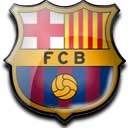
The Club Emblem
From its first football match, FC Barcelona had an emblem sewn onto the shirts. The original emblem was the city coat of arms of Barcelona, surrounded by two laurel branches, with a crown and a bat above it.
In 1910, a new emblem was introduced after a competition, which is still used today. It has undergone some modernization over time - the last being in 2002 when a streamlined version was introduced.
The emblem underwent its biggest changes during Franco's time. The initials F.C.B. were changed to C.F.B., the Castilian abbreviation of the club's name, and the four red stripes were reduced to two. For the 50th anniversary, the emblem got its two stripes back. In 1974, the original 1910 emblem was reintroduced.
The FC Barcelona Kit Colors
From the very first match, which FC Barcelona lost 0-1 against a team of English emigrants (including some members of FC Barcelona), the club's colors have been red and blue, as they are today for all sports sections.
One of the most well-known theories is that club founder Joan Gamper chose the red and blue colors in honor of his former club FC Basel. However, there is no evidence for this theory, even though the colors and kits of FC Basel and FC Barcelona are identical.
Barcelona's anthem
The current anthem was first played in 1974 on the occasion of the club's 75th anniversary. The lyrics of "El Cant del Barça" were written by Jaume Picas and Josep Maria Espinàs, and the music was composed by Manuel Valls. While the anthem's lyrics are not a literary masterpiece, they do not need to be.
The new anthem quickly became so popular that the previous anthems introduced in 1923, 1949, and 1957 fell into obscurity. Singing "El Cant del Barça" just before kick-off is a fixed ritual at Camp Nou.
The anthem of FC Barcelona and the lyrics.
Original Lyrics of the Anthem
Tot el camp!
És un clam!
Som la gent blaugrana,
Tant se val don venim,
Si del sud o del nord,
Ara estem dacord, estem dacord,
Una bandera ens agermana.
Blaugrana al vent,
Un crit valent,
Tenim un nom, el sap tothom,
Barça, Barça, Barça!
Jugadors!
Seguidors!
Tots units fem força,
Són molts anys plens dafanys,
Són molts gols que hem cridat,
I sha demostrat, sha demostrat,
Que mai ningú no ens podrà torçar.
Blaugrana al vent,
Un crit valent,
Tenim un nom, el sap tothom,
Barça, Barça, Barça!
English translation
All over the field!
It’s a roar!
We are the blaugrana people,
It doesn’t matter where we come from,
Whether from the south or the north,
Now we are united, we are united,
One flag unites us.
Blaugrana in the wind,
A brave shout,
We have a name, everyone knows it,
Barça, Barça, Barça!
Players!
Supporters!
All united we are strong,
Many years full of efforts,
Many goals we have celebrated,
And it has been proven, it has been proven,
That no one will ever break us.
Blaugrana in the wind,
A brave shout,
We have a name, everyone knows it,
Barça, Barça, Barça!
The football team's sporting achievements
Champions League
With five victories in the top-tier competition, FC Barcelona is one of the most successful clubs in this tournament.
- 1992 - FC Barcelona's first win in the Champions League (then known as the European Cup) took place at Wembley Stadium in London against Sampdoria. The match ended 1-0 after extra time, thanks to a free-kick goal by Ronald Koeman.
- 2006 - The second title was won in Paris against Arsenal FC. Barcelona won 2-1, with goals from Samuel Eto'o and Belletti.
- 2009 - Barcelona won the Champions League in Rome against Manchester United with a 2-0 scoreline. The goals were scored by Samuel Eto'o and Lionel Messi.
- 2011 - At Wembley Stadium in London, Barcelona once again defeated Manchester United, this time 3-1. The goals came from Pedro, Lionel Messi, and David Villa.
- 2015 - The most recent Champions League victory came in Berlin against Juventus with a 3-1 scoreline. The goalscorers were Ivan Rakitic, Luis Suárez und Neymar
Other international competitions
- Winners' Cup: 1979, 1982, 1989, 1997
- UEFA Super Cup: 1992, 1997, 2009, 2011, 2015
- FIFA Club World Cup: 2009, 2011, 2015
National achievements
- Primera División (Spanish League): 1929, 1945, 1948, 1949, 1952, 1953, 1959, 1960, 1974, 1985, 1991, 1992, 1993, 1994, 1998, 1999, 2005, 2006, 2009, 2010, 2011, 2013, 2015, 2016, 2018, 2019, 2023
- Copa del Rey (Spanish Cup): 1910, 1912, 1913, 1919, 1922, 1925, 1926, 1928, 1942, 1951, 1952, 1953, 1957, 1959, 1963, 1968, 1971, 1978, 1981, 1983, 1988, 1990, 1997, 1998, 2009, 2012, 2015, 2016, 2017, 2018, 2021
- Supercopa de España (Super Cup): 1983, 1991, 1992, 1994, 1996, 2005, 2006, 2009, 2010, 2011, 2013, 2016, 2018, 2023, 2025
Additionally, there have been some victories in competitions that are no longer held.
The FC Barcelona Foundation
Football is a global phenomenon. The number of FC Barcelona fans is growing not only in Catalonia, Spain, and Europe, but all around the world. There are officially registered FC Barcelona fan clubs worldwide. FC Barcelona, which also sees itself as an advocate for justice and freedom, aims to respond to the global enthusiasm for Barça.
Barça aims to be "more than a club" for the entire world. Therefore, the FC Barcelona Foundation was established in 2006, with a portion of the revenues going to it. In partnership with UNICEF, the foundation pursues the UN Millennium Goals. Since then, the FC Barcelona team has worn the UNICEF logo on their jerseys.
Other sports sections of FC Barcelona
While the Futbol Club Barcelona is certainly known for its internationally successful men's football team, the club also includes various other sports, making it a very versatile organization.
- Football: Men's and women's teams
- Basketball: Professional basketball team competing in the Spanish ACB League and the EuroLeague
- Handball: The handball team is among the best in Europe and has won numerous national and international titles
- Futsal: Professional futsal team competing in the Spanish league and international competitions
- Roller Hockey: FC Barcelona has been successful here, winning several European and national titles
- Rugby: The rugby team is less well-known compared to the other sports
- Athletics: The athletics department supports amateur athletes
- Esports: This is the newest sport that has been established at FC Barcelona. The team competes in various esports tournaments.
Book tickets here
(Click on the product images to view prices and availability)
Book your accommodation in Barcelona here! All categories.
1-5*-hotel rooms, apartments, hostels.

